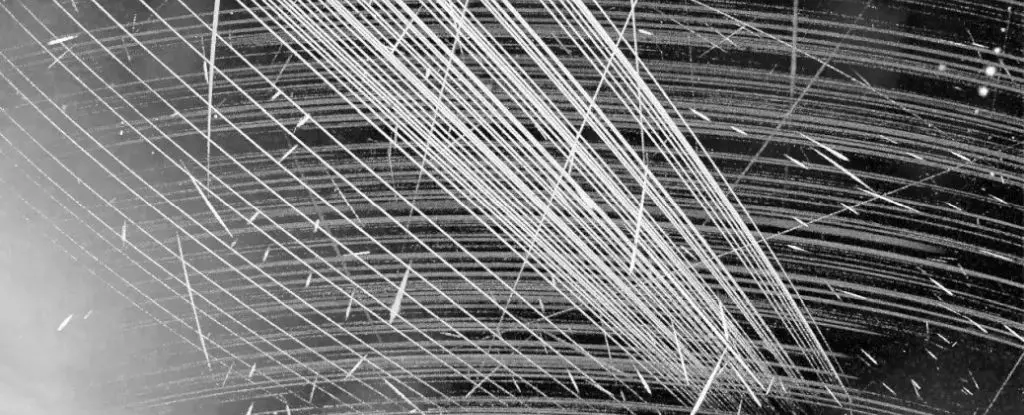In the wake of unprecedented advancements in satellite technology, humankind finds itself at a crossroads, grappling with the implications of an increasingly crowded orbital environment. The latest heart of concern centers around the Starlink satellite constellation developed by SpaceX, which has reportedly increased its radiation leakage exponentially, impacting the very foundation of radio astronomy. As the drive towards a fully connected world accelerates, the delicate balance between technological progress and environmental stewardship is at stake.
Recent observations have raised alarms about the radiation emissions from the second generation of Starlink satellites, specifically the v2mini and the v2mini Direct-to-Cell variants. These newer models have been cited as potentially emitting radiation up to 32 times higher than their predecessors. This uptick in radiation leakage poses a significant threat to radio wavelengths reserved for astronomical observations, effectively detracting from the clarity and quality of data that astronomers can collect.
Ground-based radio astronomers rely on a pristine electromagnetic spectrum to study celestial phenomena. When this spectrum becomes polluted with unintended emissions from thousands of satellites—such as those deployed by SpaceX—the consequences can be dire. The brightness of these unintended signals has been compared to the difference between faint stars visible to the naked eye and the full Moon. The disparity is staggering, marking a critical juncture in the preservation of our night skies.
SpaceX is not alone in this venture; other companies like OneWeb, Amazon, and even state-backed initiatives from countries such as China are contributing to the burgeoning constellation ecosystem. The sheer volume of satellites now orbiting Earth has transformed the night sky into a luminous sea of artificial lights, leaving trails that can interfere with not only visual observation but also serious scientific endeavor. The ramifications stretch far beyond aesthetics; they threaten to compromise essential research outputs.
A concerning study conducted last year revealed that satellites not only contribute visual pollution but that they also leak radio waves outside the designated communication bands. Specifically, emissions have been found in ranges critical for radio astronomy, emphasizing the need for effective monitoring. With existing studies demonstrating that the radiation emissions from newer satellite versions are significantly more intense, the urgency for action cannot be overstated.
Currently, the realm of low-Earth orbit is largely unregulated regarding the unintended electromagnetic radiation emitted by satellite constellations. Researchers are calling for stringent regulations to address this issue. While the radiation from a single satellite may appear insignificant, the cumulative effect of thousands of satellites can create a formidable barrier for radio astronomers, hampering our ability to study the universe comprehensively.
The call to action is clear: the industry must adopt methodologies to monitor and reduce electromagnetic interference. SpaceX has been proactive, claiming to be engaged in analyzing and addressing the problem; however, tangible results are yet to materialize. Without immediate interventions and the establishment of guidelines, the risks to radio astronomy could escalate significantly.
The stakes extend beyond astronomical research to encompass a vast array of technological advancements achieved through radio astronomy studies. Technologies such as Wi-Fi, GPS, and even innovations in medical imaging trace their roots back to research in the cosmic realm. The distortion of radio astronomy could stifle future breakthroughs we cannot even imagine, posing an existential threat to the scientific community.
It’s imperative for regulators and industry leaders to collaborate actively. As engineer Federico Di Vruno of the SKA Observatory noted, it’s essential to prioritize minimizing unintended radiation as part of responsible policies for sustainable space practices. Starlink, given its prominence, has a unique opportunity to take leadership in establishing best practices within the burgeoning landscape of satellite technology.
As humanity ventures further into the cosmos, the responsibility of safeguarding our observational integrity cannot be overlooked. We are, as ASTRON’s scientific director Jessica Dempsey aptly pointed out, at a critical inflection point. Immediate and concerted action is required to address the interference from satellites before we lose our ability to monitor and explore the universe authentically. The burgeoning satellite age should not eclipse the profound mysteries of the cosmos that await our diligent study—preserving the integrity of our skies is not merely an astronomer’s concern; it is a duty owed to all of humanity.


Leave a Reply